Mexico is preparing a major shift in its trade policy, approving broad tariffs on imports from Asian countries without free-trade agreements, including China, India, and South Korea. According to The Economic Times, the Senate passed the bill on December 10, 2025, with 76 votes in favor, 5 against, and 35 abstentions.
The global automotive supply chain is experiencing significant restructuring as the divide between China and other major economies widens. China's intensified efforts to achieve full self-sufficiency in both hardware and software for automotive technology are imposing a new technological barrier that challenges Taiwan's position, particularly in integrated circuit (IC) chip and smart algorithm supply.
EV battery fires in underground parking lots have drawn significant attention in South Korea. In response, the South Korean government is implementing comprehensive safety policies covering the entire battery lifecycle, from manufacturing and vehicle operation to disposal.
Yulon Mobility Group (YMG) subsidiaries Carplus and Singan, known for their steady operations in automotive, travel, and vehicle services, are pursuing future strategies centered on ESG and AI.
Foxconn Interconnect Technology (FIT), a subsidiary of Foxconn, announced on December 9, 2025, that its joint venture Smart Mobility with Saudi Arabia's Saleh Suleiman Alrajhi & Sons has officially broken ground on a manufacturing base at the King Salman Energy Park (SPARK) in Dammam. This marks a new phase for localized EV charging station production in Saudi Arabia.
South Korea's electric-vehicle (EV) charging industry has long held a technological edge, with world-class hardware and contributions to international standards. Yet its domestic market remains small, and its reliance on imported core components has pushed major players into a difficult corner.
Tesla continues to demonstrate strong growth momentum in Taiwan's new-car market, with all in-stock Model 3 and Model Y units for the current quarter already sold out. Coordinated with a large shipment of new cars arriving at the end of each quarter, December will see mass deliveries, with over 6,000 new vehicles expected to be delivered in the fourth quarter, an increase of 68% compared to the same period in 2024.
For years, Christmas has marked the peak season for the US automotive aftermarket. But in 2025, the mood has shifted dramatically, leaving industry players far less optimistic.
Coplus, a Taiwan-based precision automotive parts maker, held its investor briefing on December 8, 2025, where Chairman Baihua Wu outlined two strategic priorities for the company: navigating US tariff changes and accelerating the long-term expansion of its product portfolio.
Vietnamese conglomerate Vingroup has signed a memorandum of understanding with the government of Telangana for a proposed US$3 billion investment to build a multi-sector ecosystem in the southern Indian state, according to Reuters, The Economic Times, and Hindu Business Line.
SK Hynix and battery subsidiaries within SK Group received approval for 68 core patents in China in November 2025. Many of these patents relate to highly integrated memory designs and solid-state battery stability technologies, which are expected to accelerate the development of next-generation AI chips and electric vehicle batteries, enhancing competitiveness in the Chinese market.
More coverage



